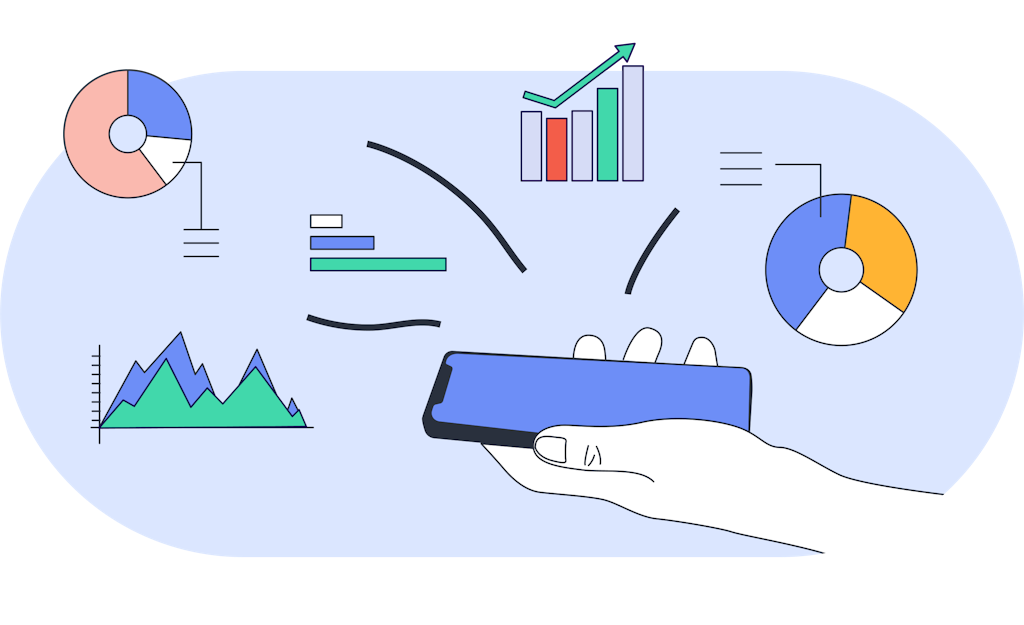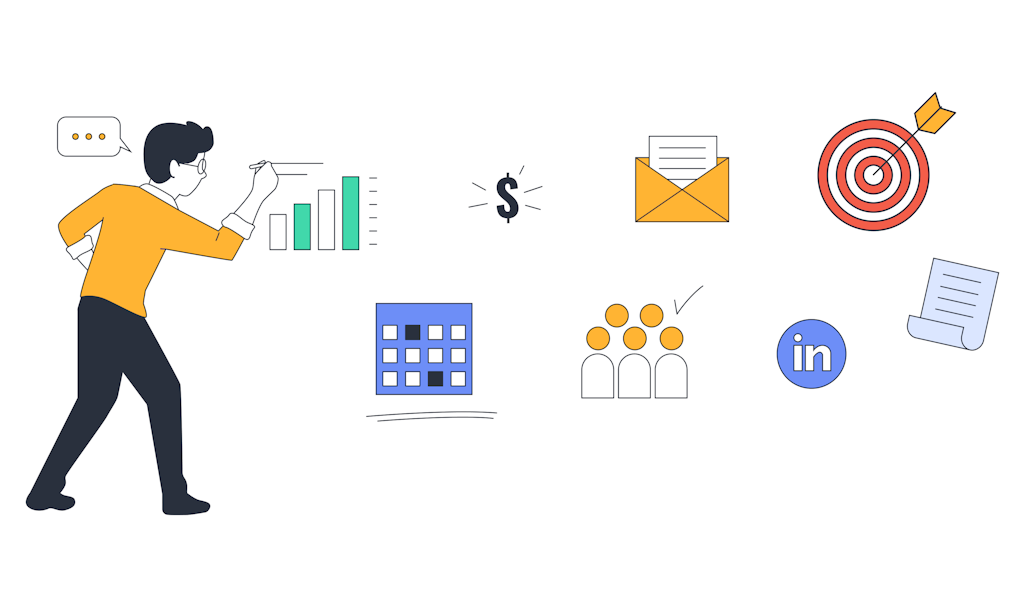What Are Intent Signals & How to Use Them?
What Are Intent Signals & How to Use Them?

Staying ahead of your competition requires a deep understanding of the subtleties driving customer behavior. Intent signals are a vital concept in modern marketing that can give businesses a deeper understanding of customer needs and preferences.
These signals are digital breadcrumbs left behind by potential customers interacting with online platforms, revealing their interest in specific products or services. In B2B marketing, intent signals enable precise targeting, personalized content delivery, and the potential to shorten sales cycles while optimizing marketing spend.
Understanding Intent Signals
Understanding Intent Signals
Intent signals are the digital footprints, data, or behavioral cues potential customers generate as they interact with online platforms and content. The signals include various online activities, from search engine queries and social media interactions to website visits and email engagements.
Intent signals allow businesses to target their marketing efforts precisely, customize content to provide value, address potential customers' specific needs and questions, and minimize ad spend on uninterested parties.
Intent signals differ from traditional demographic and behavioral data points that have been central to marketing strategies. While demographic data provides information about who the potential customers are, intent signals reveal what they are interested in and actively searching for.
In addition, behavioral data focuses on actions related to purchase goals, but intent signals pinpoint actions and behaviors that directly indicate a potential purchase.

The Role of Intent Signals in B2B Marketing
The Role of Intent Signals in B2B Marketing
Intent signals are the driving force behind effective marketing strategies. Here are ways how these signals inform marketing decisions.
Content creation
Content creation
Intent signals enable businesses to create content that directly addresses the questions and needs of potential customers. This strategy increases user engagement and positions the company as an industry authority.
Segmentation
Segmentation
By analyzing intent signals, marketers can group their audience based on interests and purchase intent. Segmentation facilitates the delivery of tailored messages and offers to specific groups, enhancing the relevance of marketing campaigns.
Lead scoring
Lead scoring
Intent signals help businesses prioritize leads based on their conversion likelihood. Leads showing strong intent signals can be fast-tracked through the sales funnel.
Users will likely interact with content that addresses their questions and interests. As a result, businesses boost their chances of closing deals and optimizing marketing budgets, reducing wastage.
For example, Adobe's Marketo Engage platform employs intent signals to identify and prioritize high-intent leads. This strategy allows their marketing and sales teams to focus on leads most likely to convert, increasing efficiency and revenue.
Also, LinkedIn leverages intent signals by allowing advertisers to target users based on their professional interests and interactions. Advertisers can tailor their campaigns to match users' job titles, industries, and content engagement, ensuring their messages resonate with the right audience.

Types of Intent Signals
Types of Intent Signals
Understanding the various types of intent signals is essential for marketers looking to leverage them effectively. Intent signals can be classified into two categories:
First-party intent signals
First-party intent signals
These are signals generated from direct interactions within a company's digital ecosystem. Examples include website visits, content downloads, email interactions, and webinar registrations.
Third-party intent signals
Third-party intent signals
They originate from external sources, including data aggregators, intent data providers, or publishers. Examples of third-party intent signals are users visiting industry-related websites, participating in relevant webinars, or engaging with content on social media platforms.
Behavioral indicators and online activities generating intent signals include search queries, content engagement, email interactions, social media activity, and website behavior. Timing and context are crucial in interpreting intent signals.
For example, a user who conducted a search query for a product yesterday is likely to have a higher intent than someone who searched for the same product several months ago.
However, understanding the context of the intent signal is equally vital. A person reading a blog post about the latest trends in a specific industry may be researching for information rather than showing an immediate buying intent.
See the magic for yourself
See the magic for yourself
Why waste time on prospects that don't convert?
Get a free trial or book a personalized demo.
Start now Why waste time on prospects that don't convert?
Get a free trial or book a personalized demo.
Free Trial
Dedicated CSM
Global Coverage
GDPR compliant
Collecting and Analysing Intent Signals
Collecting and Analysing Intent Signals
The ability to collect and analyze intent signals is a vital skill for businesses looking to stay competitive. Capturing intent signals requires access to various data sources, including:
Website analytics
Website analytics
Tools like Google Analytics provide valuable insights into user behavior on your website, allowing you to track page views, time spent on site, and content engagement.
Search data
Search data
Search engines like Google and Bing offer search query data that can reveal what users are searching for.
Social media monitoring
Social media monitoring
Social listening tools like Hootsuite or Brandwatch help track social media interactions, conversations, and trends relevant to your industry.
Email marketing platforms
Email marketing platforms
Mailchimp or HubSpot gives data on email open rates, click-through rates, and user interactions with email campaigns.
To effectively analyze intent signals, businesses can leverage various technologies and platforms:
Customer relationship management (CRM) systems
Customer relationship management (CRM) systems
CRMs like Salesforce or HubSpot can integrate intent data with customer profiles, helping sales and marketing teams make data-driven decisions.
Marketing automation tools
Marketing automation tools
Data analytics software
Data analytics software
Tools like Tableau or Google Data Studio allow for in-depth analysis of intent data, helping uncover trends, patterns, and actionable insights.
With data privacy regulations like the General Data Protection Regulation (GDPR) and the California Consumer Privacy Act (CCPA), it's crucial to follow best practices to ensure data privacy and compliance. Some best practices include data encryption, consent, user data access, transparency, and regular auditing.

Utilizing Intent Signals in B2B Marketing
Utilizing Intent Signals in B2B Marketing
Having collected and analyzed intent signals, the next crucial step is to put this valuable information into action within your B2B marketing strategies. First, start by segmenting your audience based on insight signals. Develop an intent scoring system to assign scores to prospects based on the strength of their signals–target high-scoring prospects with more urgency and relevance.
Afterward, implement behavior-triggered communication. For example, if a prospect visits a product page, trigger an email or notification with additional information or an offer related to that product. Continually test and refine personalized content and messaging to optimize results.
In account-based marketing (ABM), use intent signals to identify accounts with a collective high intent. Tailor your ABM campaigns to address these high-intent accounts' needs and interests.
Also, integrate intent signals into your lead scoring model. Assign higher scores to leads showing stronger intent signals, which will help your sales team prioritize their efforts effectively.
Best Practices for Maximising Intent Signals
Best Practices for Maximising Intent Signals
Implement real-time intent signal tracking to capture and respond to changes in user behavior as they happen. This agility allows for immediate adjustments to your marketing strategies.
In addition, develop clear lead handover protocols to ensure high-intent leads are seamlessly transferred from marketing to sales teams for swift follow-up. Integrate your CRM system and marketing automation platform to enable the sharing of intent data between sales and marketing teams.
Always prioritize data privacy and compliance, ensuring you obtain proper consent and protect user data according to relevant regulations. Also, ensure your intent signal capture and analysis processes can scale with your business. Invest in systems that can handle growing data volumes and complexity.
As digital marketing evolves, tapping into intent signals is critical for staying ahead of the competition.
As digital marketing evolves, tapping into intent signals is critical for staying ahead of the competition.
Ocean.io is a cutting-edge platform specializing in intent data and B2B marketing solutions. We offer tools and data-driven capabilities that can supercharge your marketing efforts.
Whether you need to identify high-intent prospects, personalize content, or align sales and marketing strategies, contact us today for us to help you do it smarter and more efficiently.
Get started Ocean.io is a cutting-edge platform specializing in intent data and B2B marketing solutions. We offer tools and data-driven capabilities that can supercharge your marketing efforts.
Whether you need to identify high-intent prospects, personalize content, or align sales and marketing strategies, contact us today for us to help you do it smarter and more efficiently.
